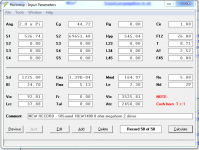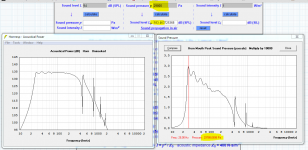Hi Mark,
So, what is the question?.
Why do you call it a "mass loaded" tapped horn?
The simulation model developed by Oliver and linked in the post below is probably as close as you are going to get to Bill's design, using Hornresp.
http://www.diyaudio.com/forums/subw...binet-16-hz-organ-speaker-35.html#post4443937
Bill's suggested "reentrant" tapped horn design should not be modelled as a compound horn. A standard Bose Acoustic Wave Cannon type design on the other hand, should be.
Kind regards,
David
Well maybe it's an error on my part.
My name calling is based on the mass of air that is on the front of the cone side. But as you guys have pointed out, it is basically a tapped horn with a deep tap position.
Sorry for the confusion.
And I never did finish my question did I?
At the moment I don't have the time to get back into this design.
I might in a few weeks.
Deep Throat
See attached PDF file for the product of my latest effort.
Note that the design calls for dimension adjustment during an iterative design/ simulation process. Convergence to optimality may lead to a not so deep driver placement as well as a no so low tuning by varying the designated length dimensions.
Air "mass loading" of the driver is expected to occur at frequencies where phase velocity approaches infinity. Here the driver and a column of air vibrate in unison; so the effective vibrating mass is larger than that of the driver alone.
Regards,
Bill
Hi Mark,
So, what is the question?.
Why do you call it a "mass loaded" tapped horn?
The simulation model developed by Oliver and linked in the post below is probably as close as you are going to get to Bill's design, using Hornresp.
http://www.diyaudio.com/forums/subw...binet-16-hz-organ-speaker-35.html#post4443937
Bill's suggested "reentrant" tapped horn design should not be modelled as a compound horn. A standard Bose Acoustic Wave Cannon type design on the other hand, should be.
Kind regards,
David
See attached PDF file for the product of my latest effort.
Note that the design calls for dimension adjustment during an iterative design/ simulation process. Convergence to optimality may lead to a not so deep driver placement as well as a no so low tuning by varying the designated length dimensions.
Air "mass loading" of the driver is expected to occur at frequencies where phase velocity approaches infinity. Here the driver and a column of air vibrate in unison; so the effective vibrating mass is larger than that of the driver alone.
Regards,
Bill
Attachments
Last edited:
Bill,See attached PDF file for the product of my latest effort.
Note that the design calls for dimension adjustment during an iterative design/ simulation process.
Bill
Reversing the driver would allow for better cooling and also allow the VTC (volume of throat chamber, the area the driver occupies presently, designated LC in your plan) to be adjustable over a wider margin in the Tapped Horn Wizard.
For the frequencies of interest in your "Deep Throat" tapped horn, rounding the corner folds won't make any difference other than reducing the internal volume, which reduces output.
Nifty use of Sono Tube for a TH.
Art
Last edited:
DTS - Design Notes
Why didn't I thank of that
The volume difference is miniscule and acoustically equivalent to a degree or two change in ambient temperature.
The purpose of fold curvature is not for the reasons you suppose.
We will be mitigating the entrapment of acoustical energy within individual air columns by reducing impedances discontinuities presented at the end folds and reducing air flow turbulence which transforms acoustical energy into the production of unwanted chaffing noises (audible or not).
The presence of a muscular 18" diameter driver, capable of excursions (xmec) in the neighborhood of 4" p.t.p., makes such concerns non-trivial.
Thanks Art for the helpful comments and complement
Regards,
Bill
Bill,
Reversing the driver would allow for better cooling and also allow the VTC (volume of throat chamber, the area the driver occupies presently, designated LC in your plan) to be adjustable over a wider margin in the Tapped Horn Wizard.
Why didn't I thank of that
For the frequencies of interest in your "Deep Throat" tapped horn, rounding the corner folds won't make any difference other than reducing the internal volume, which reduces output.
The volume difference is miniscule and acoustically equivalent to a degree or two change in ambient temperature.
The purpose of fold curvature is not for the reasons you suppose.
We will be mitigating the entrapment of acoustical energy within individual air columns by reducing impedances discontinuities presented at the end folds and reducing air flow turbulence which transforms acoustical energy into the production of unwanted chaffing noises (audible or not).
The presence of a muscular 18" diameter driver, capable of excursions (xmec) in the neighborhood of 4" p.t.p., makes such concerns non-trivial.
Nifty use of Sono Tube for a TH.
Art
Thanks Art for the helpful comments and complement
Regards,
Bill
Last edited:
I like the tube form, two of these side by side would fit lovely to a void-system. Cool wold be a small version as a rocket booster 
Interessting thought. What about mass inertia?Air "mass loading" of the driver is expected to occur at frequencies where phase velocity approaches infinity. Here the driver and a column of air vibrate in unison; so the effective vibrating mass is larger than that of the driver alone.
I like the tube form, two of these side by side would fit lovely to a void-system. Cool wold be a small version as a rocket booster
Interessting thought. What about mass inertia?
That applies to that of the driver equally as well.
Bill,Based on Art's advice I have reworked the design. It is much better now. WHG
Looks cool!
How does it compare in Hornresp to a BR with the same low corner and external volume?
Art
Deep Throat Revisited
Haven't run a simulation loop yet to tweak the mouth & throat dimensions, Lm & Lt. Note that changing these dimensions using the "stretch" command in AutoCAD is very easy to do in a minute or two. As a simulation will take a lot more time, it will be a week or two before can I get to this task. I will be disappointed if I can not surpass the performance of an equivalent BR.
I have attached a drawing and data sheet for the latest version which is a bit longer to support a 16 Hz. tuning. WHG
Bill,
Looks cool!
How does it compare in Hornresp to a BR with the same low corner and external volume?
Art
Haven't run a simulation loop yet to tweak the mouth & throat dimensions, Lm & Lt. Note that changing these dimensions using the "stretch" command in AutoCAD is very easy to do in a minute or two. As a simulation will take a lot more time, it will be a week or two before can I get to this task. I will be disappointed if I can not surpass the performance of an equivalent BR.
I have attached a drawing and data sheet for the latest version which is a bit longer to support a 16 Hz. tuning. WHG
Attachments
Hi sladdbarn,
Unfortunately, the way that Hornresp has evolved, it would now require just too much work to make the suggested change. You may however be able to get somewhere close to the desired functionality by using the Undo / Redo feature to step backwards or forwards through the different design iteration alterations made to the current open record. It would be necessary to re-calculate results though, so that they can be compared to the previously calculated ones.
You're welcome .
.
Kind regards,
David
I think that "compare previous" is a useful tool, is it possible to have more than one step back or does that take a lot of programming?
Unfortunately, the way that Hornresp has evolved, it would now require just too much work to make the suggested change. You may however be able to get somewhere close to the desired functionality by using the Undo / Redo feature to step backwards or forwards through the different design iteration alterations made to the current open record. It would be necessary to re-calculate results though, so that they can be compared to the previously calculated ones.
Thanks once again for you´re awesome program
You're welcome
Kind regards,
David
Okey. And thanks for the advice
Hi sladdbarn,
One thing I meant to include in my last post - in some cases it may be more convenient to use "Compare Captured" rather than "Compare Previous".
If you are not familiar with the Compare Captured feature, see the Compare section of the Hornresp Help file for details.
Kind regards,
David
Yes, you are simulating sending 500W to the speaker.
I would expect that to result in high pressures, everywhere.
Obviously, however the estimate is 30-40dB larger than expected
I think there is a small error somewhere in the code
When I look at the soundpressure at the horn mouth it returns a very large number
Hi Twellmann,
An excellent pickup, many thanks!
The horn mouth sound pressure is shown as being higher than the throat pressure, so there is obviously something wrong somewhere
I will investigate, and let you know what I find. It may take a day or so. The error only applies to hyperbolic-exponential horns.
Kind regards,
David
Hi sladdbarn,
One thing I meant to include in my last post - in some cases it may be more convenient to use "Compare Captured" rather than "Compare Previous".
If you are not familiar with the Compare Captured feature, see the Compare section of the Hornresp Help file for details.
Kind regards,
David
Excellent feature, thanks

Hi Twellmann,
Just letting you know that it's probably going to take considerably longer than "a day or so" .
.
The horn mouth sound pressure and particle velocity results for hyperbolic-exponential horns are not correct, but at the moment, I have no idea why. (The throat mouth pressure and particle velocity results are correct).
Kind regards,
David
I will investigate, and let you know what I find. It may take a day or so.
Just letting you know that it's probably going to take considerably longer than "a day or so"
The horn mouth sound pressure and particle velocity results for hyperbolic-exponential horns are not correct, but at the moment, I have no idea why. (The throat mouth pressure and particle velocity results are correct).
Kind regards,
David
- Home
- Loudspeakers
- Subwoofers
- Hornresp

